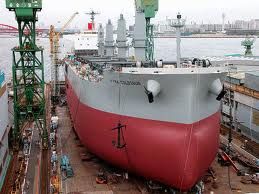
Delays building capesize commodity carriers that haul iron ore and coal fell to the lowest level in at least three years as record numbers of new vessels constructed
in China joined the fleet on schedule.
Eighty-seven percent of capesize ships scheduled to begin trading in the first six months of this year did so, according to data from Clarkson Research Services Ltd., a unit of the world’s largest shipbroker. That’s the most punctual rate of vessel deliveries since at least 2008, according to Calum Kennedy, a senior analyst with Clarkson in London, who checked how Bloomberg News calculated the delays.
Owners haven’t stopped ordering new ships even after earnings crashed 94 percent since June 2008, giving yards greater incentive to work through existing ship-construction programs as quickly as possible. China Rongsheng Heavy Industry Group Co., the nation’s largest private shipbuilder, said last month it won the biggest order for two years to build capesizes.
“There was some suggestion that yards might slow down in response to the market downturn but there are still people out there willing to order new ships,” said Kennedy. That has prompted shipbuilders to maintain the rate of construction, he said.
Delays, cancellations and deferrals of ships, known in the industry as slippage, peaked at as much as 35 percent for capesize ships three years ago, according to Kennedy.
The 13 percent of capesizes scheduled for delivery this year that were delayed compared with 31 percent for all bulk carriers, with the highest rate of non-deliveries at 51 percent for vessels half the size of capesizes, known as panamax and post-panamax ships.
Swelling Fleet
Vessel delivery influences the global supply of bulk carriers, which is forecast to expand nearly three times faster than the demand to ship commodities this year. The fleet will swell 11 percent as volumes of commodities shipped increase 4 percent, estimates Clarkson Research.
Genco Shipping & Trading Ltd. (GNK) forecast that overall slippage rates would be “upwards of 40 percent,” during a teleconference call on June 16.
Chinese shipyards hold 48 percent of the world’s orders for capesize vessels, and 52 percent for all commodity carriers, according to Clarkson data. Capesize ships are too big to use the Panama Canal and must steam around South America’s Cape Horn or Africa’s Cape of Good Hope.
At the beginning of 2011, Clarkson forecast that slippage rates for the entire dry bulk fleet could reach 45 percent this year.
The output of ships from Chinese yards, including well- established, government-owned shipbuilders with skills to build more complicated vessel types, grew in the first half of 2011, particularly January, Kennedy said.
Capesize Record
Thirty-seven of the 113 capesizes delivered in the first half, totaling 20.3 million deadweight tons of transportation capacity, came in January, the data show. One new capesize ship joined the global fleet every 33 hours in 2011 until June 7, according to a Fearnley Consultants AS presentation in London last month. There would be a record number of capesize ships delivered this year, Fearnley director Sverre Bjorn Svenning said at the event.
Slippage rates for handymax-sized ships were 28 percent, and handysize ships, the smallest bulk carriers with cargoes of up to 35,000 tons, had 44 percent of expected deliveries delayed.
The data were compiled using an annualized figure based on the number and deadweight tonnage of ships delivered in the first six months of 2011, according to Clarkson. That was compared with the number of ships Clarkson scheduled for delivery in 2011 on Jan. 1.
Source: Bloomberg
We use cookies to improve your experience. By continuing to use our site, you accept our Cookies, Privacy Policy,Terms and Conditions. Close X